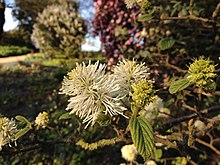
Fothergilla gardenii

| Fothergilla gardenii | |
|---|---|

| |
| Scientific classification | |
| Kingdom: | Plantae |
| Clade: | Tracheophytes |
| Clade: | Angiosperms |
| Clade: | Eudicots |
| Order: | Saxifragales |
| Family: | Hamamelidaceae |
| Genus: | Fothergilla |
| Species: | F. gardenii
|
| Binomial name | |
| Fothergilla gardenii | |

Fothergilla gardenii, also known by the common names witch alder,[1] dwarf fothergilla,[2] American wych hazel,[3] and dwarf witchalder[citation needed] is a deciduous shrub in the Hamamelidaceae family. It is one of two species in the genus Fothergilla.[1][2]

Description
- Type: Slow-growing[2] deciduous shrub.[1][2]
- Height/spread: Max height and spread is 0.9 m (3 ft)[2] to 1 m (3 ft).[1]
- Leaves: Dark green, alternate leaves emerge in spring[1] and range in shape from oval[1][2] to obovate.[1] Sizes up to 6 cm (2.5 in) in length,[1] with irregularly[2] toothed margins.[1][2] Striking autumn colors, including bright red,[1] crimson,[2] orange, and yellow.[1][2]
- Inflorescences: Terminal cylindrical[1] spikes[1][2] to 4 cm (1.5 in) are borne in spring,[1] before the leaves emerge.[1][2]
Distribution
Native to the southeastern USA,[1][2] from North Carolina to Alabama.[2]

Cultivation
- Hardiness: Fully hardy,[1] to -29 °C (-20 °F).[2] USDA zones 5-9.[2]
- Cultivation: Prefers full sun[1][2] or partial shade[1] and humus-rich, well-drained soil which is kept moist.[1][2] Full sun gives the best autumn color.[2] Does well in woodland gardens or shrub borders.[1]
- Propagation:
- Pests and Diseases: Trouble free.[1]
Cultivars
The cultivar 'Blue Mist' is grown for its glaucous blue-green foliage.[1][2]

Etymology
Fothergilla is named for Dr. John Fothergill (1712-1780) of Stratford, Essex, a physician and introducer of American plants.[3]

Gardenii is named for Dr. Alexander Garden (1730-1791), an Anglo-American botanist and correspondent with Carl Linnaeus.[3]

References
- ^ a b c d e f g h i j k l m n o p q r s t u v w x y z aa ab ac ad Brickell, Christopher "The Royal Horticultural Society A-Z of Garden Plants (Volume 1: A-J)", 3rd ed. Copyright 1996, 2003, 2008 Dorling Kindersley Ltd., London. ISBN 9781405332965 pp. 452-453
- ^ a b c d e f g h i j k l m n o p q r s t u v w x Hogan, Sean, chief consultant. 2003, 2004. "Flora A Gardener's Encyclopedia", Global Nook Publishing Pty Ltd, Timber Press. ISBN 0881925381. pp. 608
- ^ a b c Gledhill, David (2008). "The Names of Plants". Cambridge University Press. ISBN 9780521866453 (hardback), ISBN 9780521685535 (paperback). pp 169, 175
- Thomas G. Ranney and Nathan P. Lynch, Clarifying Taxonomy and Nomenclature of Fothergilla (Hamamelidaceae) Cultivars and Hybrids, HORTSCIENCE 42(3):470–473. 2007.
See what we do next...
OR
By submitting your email or phone number, you're giving mschf permission to send you email and/or recurring marketing texts. Data rates may apply. Text stop to cancel, help for help.
Success: You're subscribed now !
